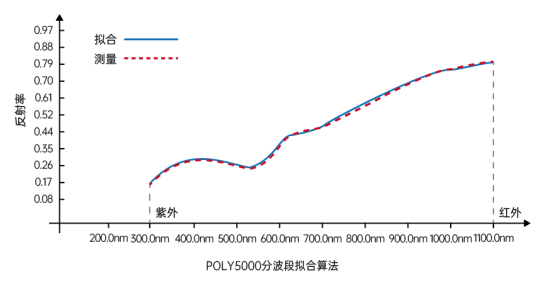
量子效率测试仪
PL/EL一体机
Sinton硅片少子寿命测试仪
Sinton硅块少子寿命测试仪
绒面反射率测试仪
3D共聚焦显微镜
清洗制绒工作站
在线四探针方阻测试仪
全自动扫描四探针方阻测试仪
在线薄膜厚度测试仪
晶化率测试仪
Horiba显微共焦拉曼光谱仪
傅里叶红外光谱仪
霍尔效应测试仪
分光光度计
全光谱椭偏仪
Horiba椭圆偏振光谱仪
TLM接触电阻率测试仪
超景深显微镜
网版智能影像测量仪
全自动影像测量仪
卧式拉力机
电池片稳态光衰老化试验箱
电池片紫外老化试验箱
电池片拉脱力综合测试仪
外观检验台
湿漏电测试系统
组件实验室EL测试仪
紫外老化试验箱
稳态光衰老化试验箱
电流连续性监测系统
PID测试系统
旁路二极管测试系统
LeTID测试系统
反向电流过载系统
脉冲电压测试系统
绝缘耐压测试仪
接地连续性测试仪
绝缘耐压接地测试仪
湿热环境试验箱
湿冻环境试验箱
热循环试验箱
动态机械载荷测试机
静态机械载荷测试机
冰雹冲击试验机
引出端强度试验机
霰弹冲击试验机
抗划伤(切割)测试机
剥离试验机
万能材料试验机(单臂)
万能材料试验机(双臂)
光伏玻璃透过率测试仪
醋酸测试试验箱
交联度测试系统
二极管接线盒综合测试仪
落球冲击试验机
半自动四探针
全自动探针式台阶仪
多通道太阳能MPPT系统
Horiba稳瞬态荧光光谱仪
钙钛矿P1激光划线测试仪
钙钛矿在线膜厚测试仪
钙钛矿工艺检测工作站
手持式IV测试仪
便携式EL测试仪
手持热成像测试仪
户外组件IV测试仪
户外组件多通道测试系统
光伏逆变器电能质量测试仪
无人机EL检测仪
高效在线监测POLY膜厚方案——POLY5000在线膜厚测试仪
日期:2024-01-05浏览量:20
对于Poly膜厚的精准把控和实时检测一直是提升太阳能电池性能过程中的一个难点。为了解决膜厚精准测量和分析,各类膜厚测量手段和设备层出不穷,但数据精准度不高、测试范围不满足、测试时间太长等缺陷依然制约着膜厚检测。面对这些困难,美能POLY5000在线膜厚测试仪的应对方式有哪些?

0.5nm超高重复性精度
美能专为光伏客户研发出一款光谱范围为300nm-1100nm,光斑为70μm的「光谱仪」,专为适应光伏行业的测试环境及条件。搭配美能创新的「光谱拟合法」,拟合获得薄膜厚度、光学常数以及膜厚均匀性等信息,实现超广测量范围20nm-2000nm和0.5nm超高重复性精度。

光强均匀,频谱稳定
传统的LED光源,平均有效光谱范围只有400nm-780nm,且在480nm附近会有光谱缺失,导致频谱不稳定,无法保证测试结果的准确性。POLY5000采用独特的钨卤素灯,有效光谱范围可达320nm-2400nm。该光源可涵盖从紫外线到红外线的所有光波段,并且能发射出连续光谱,保证测试结果的准确性。

快速、自动的5点同步扫描
POLY5000是专为光伏工艺监控设计的在线POLY膜厚测试仪。不同于其他的膜厚测试设备,POLY5000可以对样品进行快速、自动的5点同步扫描,获得样品不同位置的膜厚分布信息。并且根据不同客户、不同样品大小,POLY5000能够定制测量尺寸,满足绝大部分电池片测试需求。

在线监控设备,保证生产效率
POLY5000可100%监控LPCVD和PECVD沉积工艺,设备自动测试代替人工离线测试,非接触、无损测量,保证零碎片率。单片测试时间<0.5s,保证生产效率。
在光伏行业全面发展的今天,我们愿与客户一起提升产品质量、成本竞争力和量产优势。在这一过程中,「美能光伏」致力于研发各种精密检测设备,并提出多种电池组件研发解决方案,为客户提供更多选择。




































































